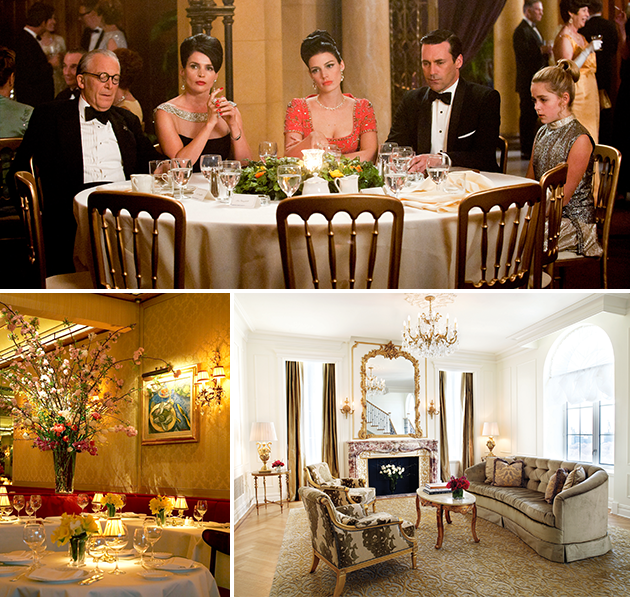
Though Mad Men’s Don Draper — the 1960s New York ad exec at the center of the hit TV show — gives us plenty of drama to analyze every week around water coolers and blogs, the program’s most prolific character could be its set pieces. This fascinating world filled with lavish restaurants and sultry bars captivates not just because of its aesthetic appeal, but also with its consistent authenticity. As the new season’s April 7 premiere nears, we consult Claudette Didul, the show’s set decorator, for insight into how she transports millions of viewers to mid-century New York — and how those sets compare to luxury hotels and restaurants today.
Didul joined the Mad Men team during the show’s fourth season—in plot terms, the show has progressed from November 1964 to 1967 since she started. That’s an important time period for Didul on a personal level: Because she was born in 1961 to a bona fide New York City ad man, the era represents her first memories of Manhattan as a little girl.
“When we designed the Sterling Cooper Draper Pryce offices for season four, I kind of based it on the office I remember my father working at,” Didul says. “When he finished his career in the 1990s, ad offices still looked the same—with the same Pollock chairs, the same Knoll and Herman Miller furniture.
In creating the world of Don Draper, Didul finds herself playing a constant game of tug-of-war with the past. The show’s protagonist is a man who enjoys the finer things in life; as such, he likely would have frequented restaurants such as Café Chauveron, The Forum of the Twelve Caesars, La Caravelle and the Rainbow Room—restaurants that earned Four- or Five-Star ratings from Mobil Travel Guide (now Forbes Travel Guide) in 1967. However, those dining landmarks are no longer open today. Other star-rated properties from that year, such as La Grenouille and the 21 Club, still welcome diners, albeit in dining rooms that have undergone several renovations since the mid-60s.
When tasked with re-creating sets that mimic restaurants of this caliber, Didul and a team of researchers, buyers and designers dig through photographs, books, magazines and online articles to find inspiration. But they also have to overcome unexpected obstacles—like chairs.
“We try our best to find a multitude of chairs that come as close to the target period as possible, which, gets really hard because a lot of times you need about 40 of them,” Didul says. “You just hope that there’s some way everything will feel different because you do end up recycling things. We’re in 2013, and we’re trying to find stuff that’s almost 50 years old, and just trying to find stuff that looks fresh.”
Not all elements of the job are as difficult to pull off as restaurant scenes. Throughout the series, we’ve seen Don Draper and his peers stay in a number of hotel rooms. Those sets are much easier for Didul to decorate, in part, she claims, because standards of hotel décor seen in the 1960s are still applicable. “In all honesty, a lot of the style hasn’t changed much, even today. We still see a lot of classic Georgian-style furniture,” she says. “I know some hotels now are trying to go with a more mid-century hip or industrial look. But the classic hotels don’t seem like they have changed much in general. We’ve been lucky enough, too, to find fabric that looks vintage.”
If you’re hoping to live out your own Mad Men fantasies by booking a suite at one of New York’s finest hotels from Draper’s time, you’re in luck—there are five different star-rated hotels from 1967 that are still open (and providing the same level of luxurious service) today. Take your pick from The Carlyle, The Pierre, The Plaza Hotel, Waldorf Astoria New York or JW Marriott Essex House. They all earned approval from Mobil Travel Guide in 1967, and continue to hold Forbes Travel Guide Recommended or Four-Star status today.
The fact that so many iconic hotels have retained their reputation for excellence doesn’t surprise Didul, in part because ideas of luxury haven’t changed as much in the past 50 years as one might think. When we asked her what Don Draper would look for in a hotel in 1967, she told us, “a big, king-size lush bed, room service, an open bar and lots of ashtrays; and that luxurious spa feeling from back then—we’ve obviously gone further with it now, with thicker towels and robes. His idea of luxury probably would not be too far from what people want today,” she says. “Except for the ashtrays.”
Photos Courtesy of Ron Jaffee-AMC, Fairmont Hotels and Resorts and LaGrenouille

